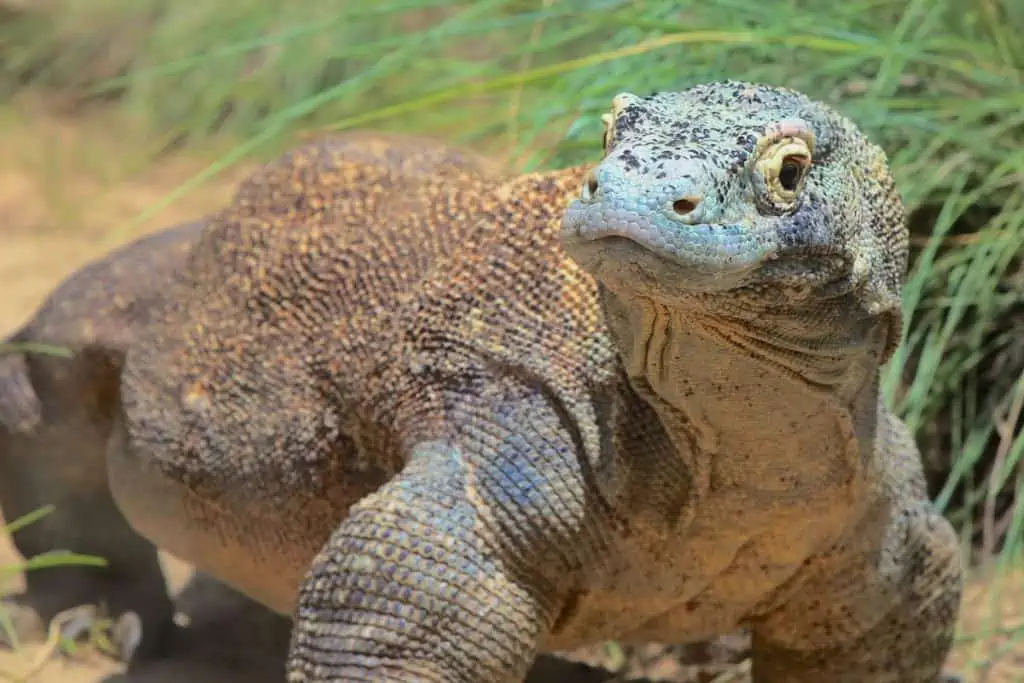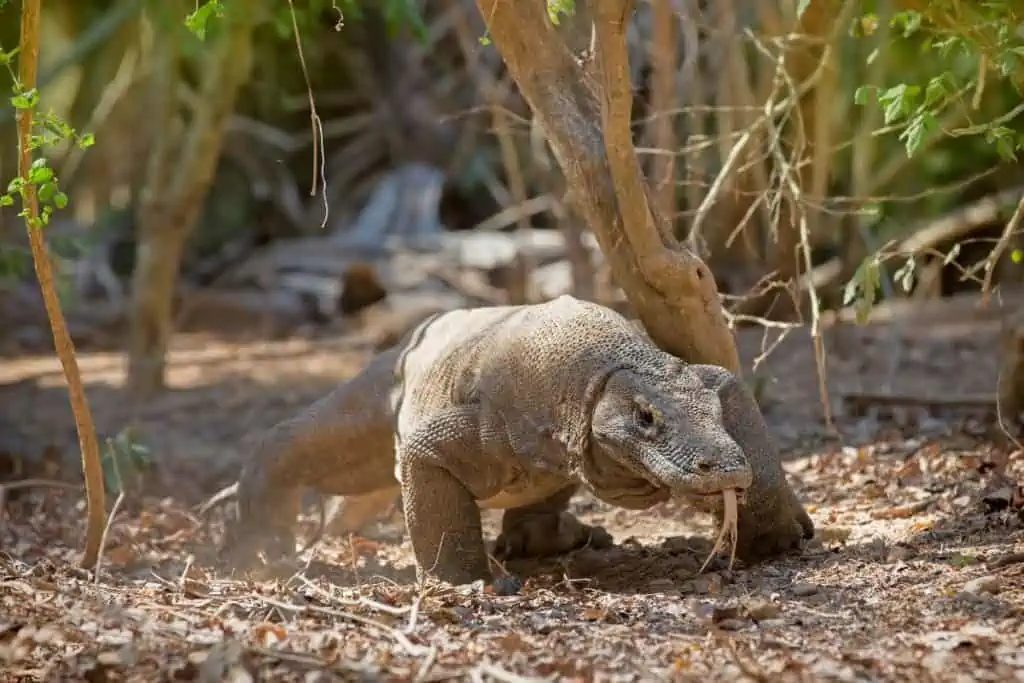Komodo dragons may seem like they are from the prehistoric era, but how old are they really? Are Komodo Dragons dinosaurs?
Komodo dragons are not dinosaurs or descendants of dinosaurs, but they have giant ancestors. Some scientists still believe that Komodo dragons are the last link to dinosaurs. However, DNA studies have linked Komodo dragons to some of the largest reptiles from the prehistoric era, which are certainly not dinosaurs.
It’s interesting to know that Komodo dragons are sometimes referred to as modern-day dinosaurs, but there aren’t many similarities. So, are they lizards? Are they reptiles? Or are Komodo dragons dinosaurs?

Who Are the Ancestors of Komodo Dragons?
Komodo dragons belong to the genus “Varanus” of Lizards, hence the name Varanus Komodoensis.
Varanus is a class of giant monitor lizards, and not surprisingly, Komodo dragons are also referred to as Komodo monitors or Komodo Island monitors, specifying their natural habitat.
Varanus Komodoensis was first found around 40 million years ago in Asia, where their evolution from the genus Varanus began.
Research suggests that they later migrated to Australia and evolved into giant lizards.
Moreover, scientists unearthed several fossils in Australia dated back to 4 million years ago, proving the origin of Komodo dragons from the Australian Islands.
Varanus Priscus, or Megalania, was the largest and has now entirely vanished from the planet.
These Komodo monitors now freely roam around the Indonesian Islands of Flores and the Island of Timor. And komodo dragons are now the giant lizards in the world, mainly endemic to Indonesian Islands.

The Origin of Komodo Dragons
Some scientists believe that even though Komodo dragons have evolved over millions of years, they wouldn’t have survived the environment of the prehistoric era where dinosaurs lived, which signifies their origin from lizards rather than dinosaurs.
Two theories explaining the origin of komodo dragons were considered true in the past. However, they are obsolete now.
1. The Island Effect
It was thought earlier that animals living on the Island needed a greater-sized gut to process low-quality food from islands, so they developed giant bodies.
2. Indirect Island Effect
Another hypothesis was about Komodo dragons hunting a small elephant (Pygmy Stegodon) for their survival on the Island. That required a larger size for the lizards to engulf the small-sized elephants. So, over time, lizards grew bigger.
Both these theories about the origin of Komodo dragons were discarded after new research.
Further DNA studies of unearthed fossils revealed that Komodo dragons and all giant lizards have the same families and belong to the same genus, Varanid.
Are Komodo Dragons Reptiles?
Komodo dragons belong to the class Reptilia. They have long tails, serrated teeth, biforked tongues, scales on their bodies, and four limbs depicting a typical picture of reptiles.
They are also categorized as Apex predators. They can swallow a whole animal. It’s nearly impossible for their prey to escape as they cause fatal injuries with venomous bites leaving the victims bathing in blood.
These giant lizards are carnivores feeding on smaller animals and may as well feed on dead animals (scavengers). They eat animals like invertebrates, mammals (including humans), birds, and, at times, smaller Komodo dragons (yes, you heard that right) to survive on earth.
If we focus on the assumption about Komodo Dragons being dinosaurs, the closest link we can consider is with the Mosasaurus, which also comes in the Reptilia group.
You may not remember the name, but if you’re a fan of Jurassic World, you’ve seen this enormous aquatic dinosaur-like creature appear in recent movies.
The Mosasaurus is an extinct group of aquatic squamate reptiles that existed around the same time as the dinosaurs.
Although they may look like marine dinosaurs, the Mosasaurus classifies as a lizard.

Are Komodo Dragons Endangered?
Komodo dragons have allegedly survived over 240 million years, originating in Australia. These lizards have certainly come a long way.
Previously, Komodo dragons were considered stable species, fearlessly fighting against the environment. Therefore, IUCN removed them from the list of endangered species.
But today, due to low numbers, these lizards are vulnerable to extinction due to extensive global climate disturbances like earthquakes, changes in sea level, tsunamis, and volcanic eruptions.
Poaching or illegal hunting of Komodo dragons is another significant risk factor for them being endangered. Moreover, the low-quality food on the islands may not benefit these animals in the upcoming years.
Due to major climatic catastrophes, changes in habitat, extinction events, and illegal hunting, these animals may not survive.
Hence, IUCN has now added komodo dragons back to the list of endangered animals.
Are There Any Living Dinosaur Descendants?
Believe it or not, there are currently living dinosaurs amongst us. No, you don’t need to look for a hidden Jurassic park on earth or travel to remote islands to see them.
Step out of the house, and look up at the sky.
Surprisingly, birds are considered living dinosaurs, according to most paleontologists. The two creatures were linked based on their skeletal makeup, nesting, and brooding habits.
Many of these traits in birds today can be related to some dinosaurs.
All dinosaurs became extinct about 65 million years ago, so direct evolution from dinosaurs is impossible.
However, paleontologists believe that birds and dinosaurs share a common ancestor, which explains their multiple common attributes.
Final Thoughts on Are Komodo Dragons Dinosaurs
Komodo dragons are a unique species of reptile. Their origin is sometimes linked to dinosaurs, but these giant animals don’t entirely fit the mold.
Komodo dragons are now considered endangered due to rapid global climate change. And without drastic intervention, within a few years, we might not see or even hear about komodo dragons again.
FAQs
Are Humans Involved in the Extinction of Komodo Dragons?
In the past years, scientists saw no proven connection between Komodo dragons and their extinction due to the human lifestyle. However, recent reports have suggested otherwise. Climate change has a huge role to play in the Komodo dragons’ extinction.
Why Did Komodo Dragons Disperse to Indonesia?
There is no evidence why Komodo dragons preferred Indonesia’s environment over Australia’s (their assumed origin). But it might be related to the change in weather or the Australian climate that didn’t suit these predators.
How Long Will the Komodo Dragon Species Survive?
Some paleontologists believe that Komodo dragons will become completely extinct by 2040. However, breeding Komodo dragons might improve their chances of survival. Some animal keepers have begun experimenting with breeding these giant lizards and have seen fruitful results.
